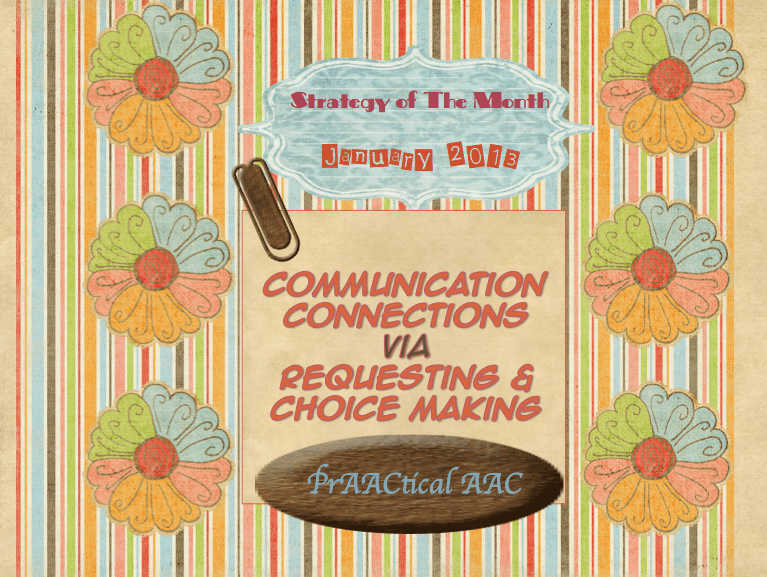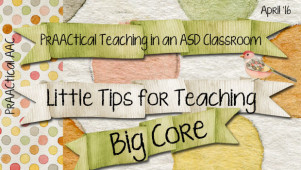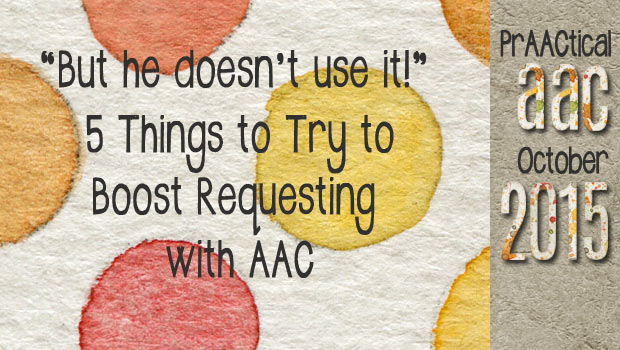Communication Connections

 The January Strategy of the Month has focused on requesting and choice making. These are really fun goals to implement. They fall under the communication function that helps us meet our own needs (Behavioral Regulation). When we get what we want, there is a sense of control over the environment & we increase symbolic communication/language, and self-sufficiency. It’s all good. The assumption for all requests and choices is that the learner ‘likes’ what they have asked for. This is what makes the process so much fun, we get to do activities and have interactions that are positive and motivating.
The January Strategy of the Month has focused on requesting and choice making. These are really fun goals to implement. They fall under the communication function that helps us meet our own needs (Behavioral Regulation). When we get what we want, there is a sense of control over the environment & we increase symbolic communication/language, and self-sufficiency. It’s all good. The assumption for all requests and choices is that the learner ‘likes’ what they have asked for. This is what makes the process so much fun, we get to do activities and have interactions that are positive and motivating.
If only it was that easy… Sometimes it is not… But do not worry…there are plenty of solutions for common (and not so common) problems when teaching requesting and choice making. As always, set the stage for a positive TEACHING paradigm and then move to problem solving if necessary (and when it is necessary, remember it is still teaching, just with some different strategies, not better or worse).
By teaching when it is easy and by problem solving when it is not, communication connections can be developed and can serve as the foundation of a language learning program for everyone.
Beginning
Setting the Stage
- Have the attitude ‘It’s ALL Good’ – Here is the chance for the learner to get what they want whether it is an object, activity, sensory input, people, etc. And at the real beginning, the attitude can be It’s ALL GREAT or What would you do for a Million Dollars type of great!
- Activity choice boards can have ALL preferred items, so whatever is chosen is good. In the beginning teaching phase, it is ok if all responses are correct. Check out the specific requesting process for building in preferred vs non-preferred options.
- At the beginning, have ALL of the choices available. No one likes ‘ordering’ from a menu to be told, sorry we are out of that. Later in the teaching process, systems of ‘not available’ items can be introduced.
- Choice boards can be created with photographs, symbols, objects, remnants, etc.
- Remember lots and lots modeling by taking your own turn to make a choice or request- often though your choice will be a quick one, just to show the expectation.
- Create activity choice boards but also within activity choice boards and then mini-choice boards. Translated- choices can be for a main category of activity (Reading/Books), then specific book (Baseball/Animal/Car book), then while reading book more requests and choices (‘turn the page’, use funny/loud/scary voice, read again, finish).
- Use many communication temptations– a request or choice only needs to be made if access is restricted in some way. Set up natural communication temptations.
- Use the language facilitation strategy of ‘Wait & Signal’.
- Use more modeling and aided language input.
- Learner does not seem to ‘like’ anything (or hardly anything). Do a preference assessment or mini-preference assessment. Observe, observe, observe. Everyone likes something. It may be sensory in nature, it may be looking at a string, it may be wanting to be alone, but everyone likes something. At this point, do not worry about ‘too much’ or ‘self stimulatory’ behaviors. If the goal is met (requesting/choice making) and a learner gets to ‘stim’ for a few seconds and asks for it 20 times, communication is occurring frequently and symbolically, there is no problem.
- Learner does not care about the choices- This is different from requesting; where it is important that the learner ‘cares’. With practice, motivation to make a choice can be increased. Maybe choices were never an option and there were limited opportunities to choose. Modeling, modeling, modeling is very effective. Look for routines and offer choices that would keep or disrupt the routine- some learners then start to notice and care. Look back at preference assessments. Arrange choices around preferences if it makes sense (i.e., several sensory options, play alone- you sit in the chair next to me, sit across the room, or sit in the middle, watch T.V.- sound loud, louder, loudest, etc.).
- Learner has too many choices- Too many choices (for a specific learner) may lead to some specific issues. We once worked with a young man who said ‘no’ to all choices when deciding how to structure his schedule. It actually did not matter if it was a choice of 2 or 8, he just immediately indicated ‘no’. Therefore, his choices ultimately became ‘who decides’. Even though it seemed counter-intuitive to us, he always wanted someone else to decide the activity. However, he did end up wanting to make within activity choices (i.e., which book to read, or which pencil to use). Another problem with perceived too many choices taking too much time to decide. A clear prompting hierarchy and extra modeling often helps in this situation. At times, limiting choices to 2-4 is helpful.
- Learner does not like any of the choices- Teach a ‘don’t like any of the choices’ or ‘offer me different choices’ symbol. If agitation occurs when looking at a choice board, it may be that a favorite choice is not available. Sometimes different choices can be offered (then no problem), but sometimes not. But at the very least we can teach the message ‘don’t like any’ as a way to let the learner vent about the situation and to take the time to commiserate with them. It is surprising that sometimes ‘venting together’ is enough to take the edge off of agitation just enough to then be able to make a choice. When communication is honored in a positive and predictable manner over time, with communication systems in place, then the more likely that the two-way communication is accepted (even if not happily).
- Learner does not like the choice selected- Make this a quick situation of staying with the choice (even just showing it). Then use aided language input (ALI) to indicate it was a mistake and if possible to re-choose. This is part of the learning process. Think how many times you (maybe just me) orders something from a menu but then ends up trading meals with someone else (my husband or daughter who are very generous and who will eat most foods).
These are just a few of the common problems. Please share other difficulties and solutions you have found.
Set the stage for requesting and choice making and you are on the way to teaching authentic communication. Be on the lookout for problems but know that finding the solutions often teaches us ALL the most. Many times we have to think outside the box to make it work but if we really ‘listen’ to what is said with actions, there is always a solution. And with solutions, there are more opportunities for making communication connections.
Filed under: Strategy of the Month
Tagged With: choice making, preferences, requesting, teaching
This post was written by Robin Parker






